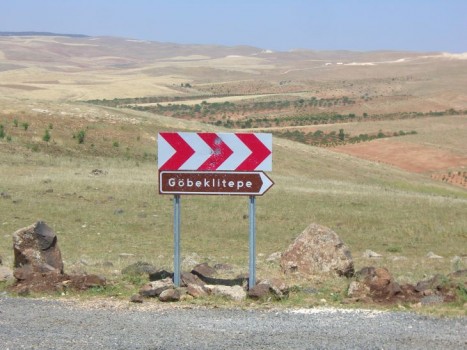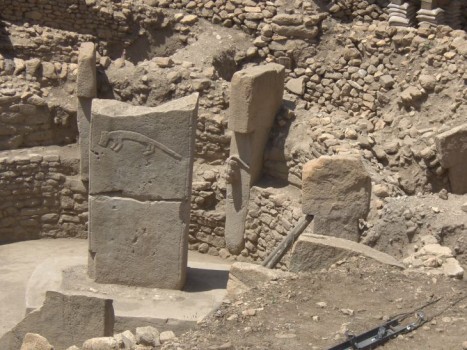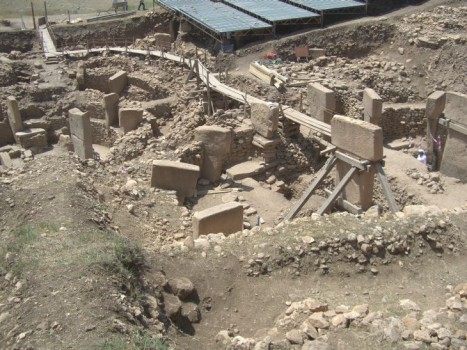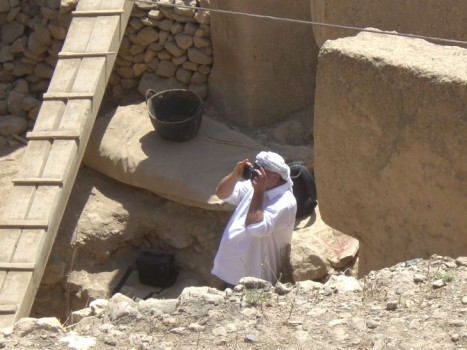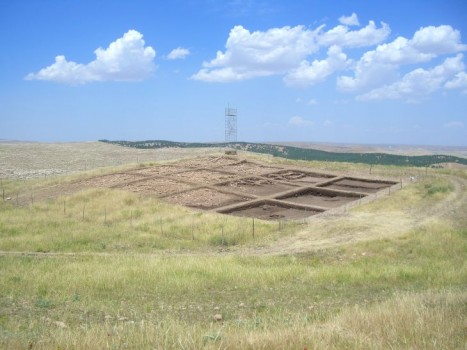-
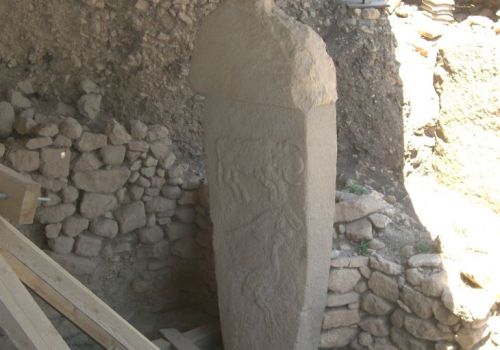
Göbekli Tepe is a world sensation. The site has been called the Garden of Eden, an archeological miracle and the missing link between hunter gatherer societies and agricultural societies. It is a mind-boggling twelve thousand years old – the oldest temple ever found. I suspect that in twenty years, the site will no longer need this introduction: it will rank up there with the Pyramids and Stonehenge for notoriety. It is that important.
It had been known for quite a while that the hill of Göbekli Tepe held some type of archeological secret, but it was assumed that it heeded back only to Byzantine times. When a routine survey hit upon the site in the mid 1990s, other much older things came to surface. A German team from the University of Heidelberg began digging for real – a dig that they now expect can go on for another fifty years (!). Soon, the archeologists realized that they were standing on a 12,000 year old site – a temple of such antiquity that it sent shock waves through the academic communities.
To understand why this the site is so important, let’s look back at how things were twelve thousand years ago. What we already know from other finds that this period marked a transition between nomadic, hunter-gatherer societies and an agricultural revolution: this is when mankind became farmers. What we don’t know is why this happened.
We do know that the area around Göbekli Tepe was very lush, full of animals and edible plants. The hunter-gatherers that lived there could multiply and prosper – in fact they were doing so well that they built themselves a big sacrificial cult site to celebrate their successful lifestyle: the temple that is Göbekli Tepe.
Given this scenario, it is logical that the people of Göbekli Tepe would eventually use up the nearby resources. Game, firewood and other necessities would have to be carried in from further and further afield. Things that previously had been a secondary source of food would become the dominant way of life. This is what the scientists believe – that the site of Göbekli Tepe is the cradle of the Agricultural Revolution, where mankind settled down into stationary settlements, living of what they could produce rather than off of what they could scour from the land.
To further set one’s imagination aflutter, there is the theory that the memory of this transition has lived on in people’s minds, through oral history and later through writings such as the Bible. The theory is that the memory of the Göbekli Tepe transition is the Biblical story of the Garden of Eden. People were living in blissful ignorance (hunting and gathering and generally only having to work for 4-6 hours/day, according to anthropological science), followed by the Fall, after which they ended up tilling the soil for 12-16 hours/day.
Crazy as this sounds, it could very well be true. Geneticists have pin-pointed that domesticated wheat originates from a wild variety that grows on nearby Mt Karacadag.
Adding a dark, sinister aspect to the mystery of Göbekli Tepe is the fact that at some point, people buried the site under tons of dirt. Why people did that is not known, but some nearby finds indicate that at some point, people were sacrificed here. It appears that children were being burned, possibly boiled in huge clay jars. Maybe. The evidence is inconclusive, but dark and nefarious details will perhaps be revealed as the excavations continue. It certainly sets the imagination a-wandering about what people were doing and feeling back then. Was there a conflict? Did the good guys win? Was a religion gone bad overthrown, and its horrible temple buried, to be found only now? We can never know – so much time has passed. What we can do is to be awed and inspired by it, and to have fun speculating about it.
Today’s Göbekli Tepe is still a pretty low-key affair. Serious excavations have only taken place at one of several promising sub-sites, and archeologists will be busy here for many years to come. At our visit, we said hello to several of the archeologists, who were busy tinkering around with spades and cameras. The site is basically an open pit, primitively fenced in with barbed wire. We walked around it three times, taking pictures and generally trying to keep out of the way. It very much feels like a work in progress – flint shards are littering the ground, and only the flimsiest barrier keeps tourists from walking straight into the pit.
This brings me to one other point: Göbekli Tepe needs protection, and that soon. Bus loads of tourists are pouring in from Antalaya and god knows where, and soon they will just completely overrun the site. I am confident that the German team will do something about this. In fact, I am guessing that it will only be a few years until all you can see of Göbekli Tepe is an interpretive center and some far-off grandstand from which you can snap pictures – just like any other world class, sensational archeological dig.
Me, I’m just happy to have seen it. Nerd as I am, it totally blew my mind.
No related posts.
Related posts brought to you by Yet Another Related Posts Plugin.
This entry was posted on Monday, May 17th, 2010 at 11:42 am and is filed under Turkey. You can follow any responses to this entry through the RSS 2.0 feed. You can leave a response, or trackback from your own site.
-
http://www.headingthere.co.uk Tom Volpe
-
http://www.headingthere.co.uk Tom Volpe
-
Skeptic
-
Ola
-
http://positivetranceformations.com.au/hypnosis-gold-coast/ gold coast hypnosis
-
http://pulse.yahoo.com/_TK2O6O3T7USB47OOIR76L5RXYU Prateek Panchal
-
Luis Guembes

